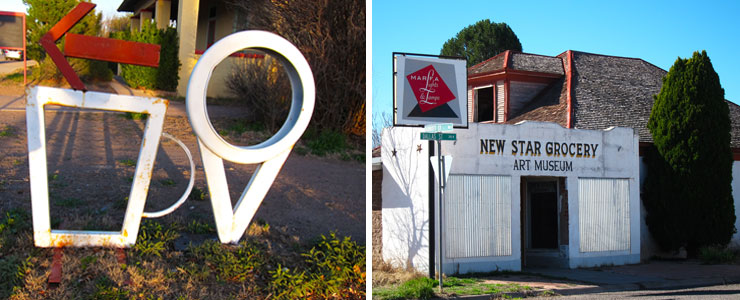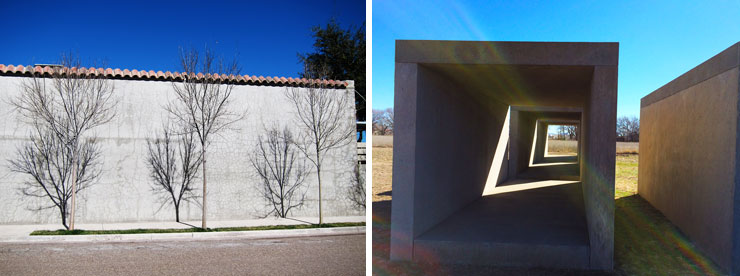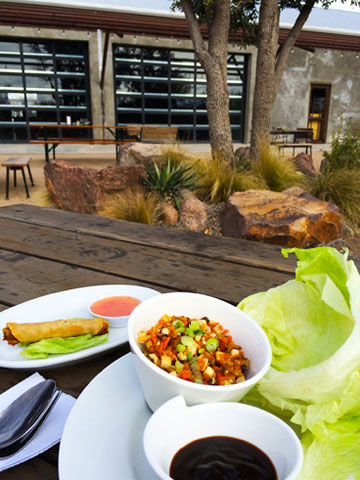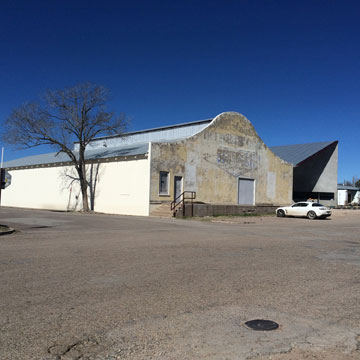
LEFT : Even the signs are clever: coffee and laundromat this way. Right : New Star Grocery Art Museum.
I travelled to Texas recently so you must hear every morsel, I'm afraid. The trip was pretty dang interesting. If you are not familiar with the weighty implications in the art world of this teensy town of Marfa, located in west Texas near the Mexican border, please take a moment. I stumbled on a New York Times article about Marfa years ago, instantly adding it to a list of things to accomplish before my sell-by date. The trip did not disappoint.
All of 2,121 people currently reside in Marfa, if one is to believe the sign at the outskirts of this oft termed "quirky" town. It is the only adjective that comes to mind as I pondered and poked about Marfa in an attempt to de-quirkify the surreal surroundings that artist Donald Judd provoked.
You can't get there from here; it's not on the way to or from anything whatsoever. I had to take two planes before I circled the drain on El Paso, then rented a car for the three-hour drive through the Chihuahuan Desert plateau of nothingness to reach Marfa. There were gaps in cell phone service and very little radio connection to hum along en route past copious tumbleweeds and dry dirt. Did I mention I opted to go solo for maximum cultural absorption without the distraction of usual life?
One apple and yet another granola bar later I arrived at my little rented adobe house in town, ready for full immersion. I ran to the famous 1930 Hotel Paisano's Jett Restaurant for a burger after the nutritional abyss of my journey. It's claim to fame was housing the cast of the 1956 movie Giant (Elizabeth Taylor, Rock Hudson, James Dean) filmed in and around Marfa. In 2006 Joel and Ethan Coen partially shot No Country for Old Men here. Since 2007 this Texas town has hosted the Marfa Film Festival. There is also a 1959 classic motel called the Thunderbird revamped for today's maximum cool status. Everything is part cow town, part inner circle, all somehow mixed and matched into a cohesive and workable whole with neither faction outdoing the other, living to the mutual benefit of all.

LEFT : The wonderful Marfa light on one Donald Judd Foundation wall. RIGHT : Donald Judd's untitled cement boxes at Chinati Foundation.
I suppose you want to hear more about the Donald Judd connection. If you must: In the '70's modern contemporary art was firmly ensconced in New York City. Sculptor Donald Judd, one of the most prominent bad boys of Minimalism had a hankerin' (yes, I am going to amuse myself with a personal version of west Texas vernacular) to expand from his Spring Street studio to realize a vision of creating very large pieces to be placed in situ, in perpetuity. He had recalled the stunning light and wide open spaces of west Texas having visited as a child and again as a military man. He moved work and young family to Marfa in 1972.
"I chose the town of Marfa because it was the best-looking and most practical, and rented a small house. Three months later, a friend, I, and my son, who was soon to eat his fourth birthday cake, lost with his elders in Baja, drove a truck full of art to Texas and unloaded it into the house and garage." (Donald Judd, 1985)
Once known as Camp Marfa, the now defunct Fort Russell military base has been the home of Judd Chinati Foundation (named after the nearby mountains) since he purchased in 1979, opening to the public in 1986 as a contemporary art museum for large works. It also includes the pieces of select artists, i.e., colleagues Dan Flavin and John Chamberlain. Judd intended his Chinati Foundation to administer the large-scale public art works he originally commissioned for Dia Foundation.
As I walked through the buildings, Dia Beacon, in Beacon, N.Y., kept popping into focus as the feeling is similar. Judd wanted his art to meld with the architecture and the surrounding vistas, not to merely plonk down a piece of art in a way unrelated to the rest of life. This came through profoundly. The longer I viewed the work — the Judd reconfiguration of this military edifice, the views outside the generously windowed, cavernous galleries, the more I saw how all was one, synergistically working off each other, the mood and the experience.

Lunch at Thunderbird motel complex.
It was a moment to reflect on how I fit into my own surroundings. As vision cleared, I saw ever more information in Donald Judd's 100 metal boxes quietly standing in military precision, mirroring the shape of the large gallery windows, the changing light whispering Judd's secrets. I peered closer and closer into them, like they were crystal balls. I was being "Judd-i-cized."
Outside and down the hill, the Texas expanse opened it's arms to Judd's large cement boxes, 15 untitled works in concrete (1980-1984) stretching along parallel to the old military base, causing the midday Texas light to play amongst the boxes, flirting with shadows and shapes til I was mesmerized and suddenly aware that I was. . . happy. Donald Judd was getting "got" way out where tumbleweeds are common as cornbread.
Donald Judd died in 1994 and the Judd Foundation was put in place to manage the many converted living and working buildings he purchased for artist's residence, art studio, architecture studio, library, archives and ranch office. Tours are available on specific days.
As the week wore on, I meandered the streets of Marfa, realizing my Tuesday arrival heralded the deadest Marfa days of Monday/Tuesday — not to mention a quiet time of year. There was meager signage as the art community tried to blend into the cattle community seamlessly. Besides the Judd and Chinati Foundations, private galleries opened as the week progressed; I discovered that it was a "Where's Waldo?" activity to decipher what is an art venue and what is still a derelict building. The secret lay in the cleanliness of the peeling paint and walls as well as the quality of the windows.
The artfully resurrected Marfa Wool and Mohair Building in town houses 22 of John Chamberlain's substantial painted chrome and steel sculptures. Dan Flavin's large scale fluorescent light tube sculptures have been installed in six of the Chinati's old military dorms since 2000, creating barriers of 8 foot long tubes barricading the corridors physically but not visually in the middle of the U-shaped galleries.
A once a week newspaper alerted me to a screening of Altman with Director Robb Mann on hand for discussion. At the allotted hour I located the unmarked Crowley Theater on a dusty side street ensconced in an old feed warehouse. I saw no one gathering for the screening but persevered, wondering how I got the night wrong.
The door opened to my tug. People from nowhere suddenly meandered into the lovely, rustic screening room. I wasn't sure what happened. Small arty flash mobs would quickly appear at appointed times, then disappear; but other than that the streets were quite empty. The act would be repeated over and over that week. I attended several gallery openings and sampled creatively modern food served in places that took some sleuthing to uncover. Marfa does not act like your town or my town. Areas run no natural ebb and flow of uptown, downtown, art area, commercial things just, well, pop up, unannounced.

Crowley Theater in old feed warehouse.
I went to Building 98 at the old military base to see Washtub Jerry's electronic art opening — and I must tell you about the Marfa Lights. I drove nine miles out of town in the inky blackness of the desert at 8 o'clock at night to watch for the eerie lights that often show up at the foothills far in the distance. No one knows what they are, but have been spotted since the late 1800s. I was not lucky enough to see them, but expect "A" for Effort on this one. It. . . was . . . dark.
If I was ever to be abducted by aliens, this was the moment. Alas, I made it back to tell my story.
By the way: 35 miles outside of town there is a famous sculpture by the Scandinavian artists Elmgreen and Dragset, a small shack sized store, permanently locked, by the side of lonely state road 90, with real Prada shoes and bags inside and the PRADA label sign overhead. It was in a state of rehab dishabille I was disappointed to see, after all the hoopla in the Marfa articles. Also Marfa Ballroom makes you feel like you stepped into MoMA after traversing the old trucks parked across the street. Forget a mindset.
Marfa, Texas: http://www.visitmarfa.com/hotels.php#.VQHgj0tyFuY
The Chinati Foundation:https://www.chinati.org/visit/collection/
Marfa Film Festival:http://www.marfafilmfestival.com
60 Minutes on Marfa:http://www.cbsnews.com/news/marfa-texas-the-capital-of-quirkiness-04-08-2013/
 MAIN MENU
MAIN MENU

